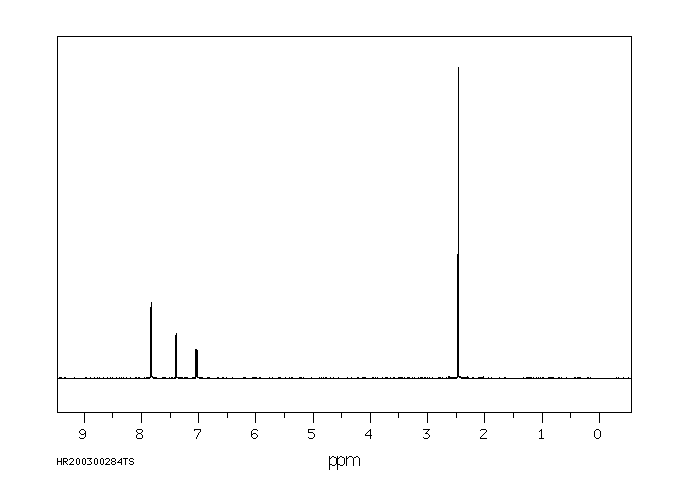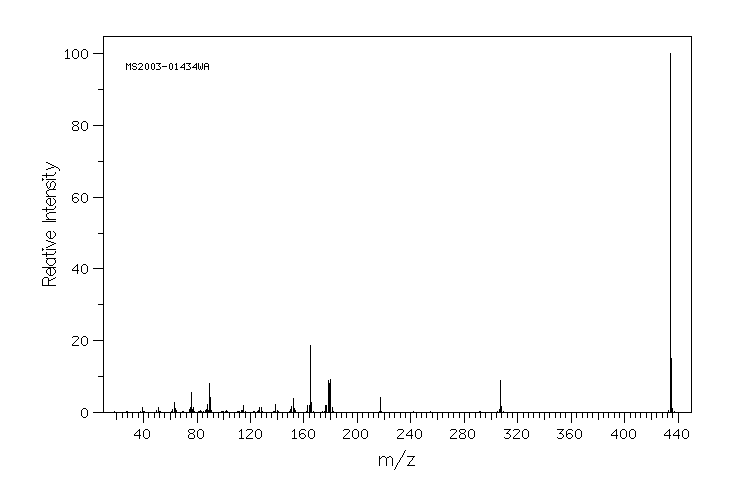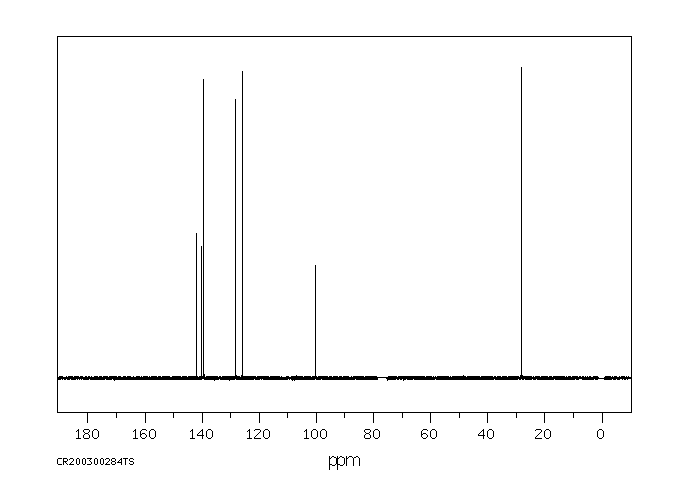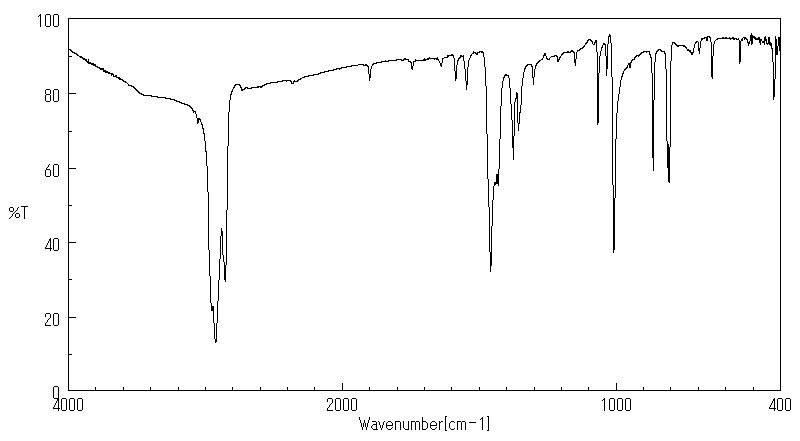4,4'-二碘-3,3'-二甲基联苯 | 7583-27-9
中文名称
4,4'-二碘-3,3'-二甲基联苯
中文别名
3,3二甲基-4,4-二碘联苯;4,4'-二碘-3,3-二甲基联苯
英文名称
4,4'-diiodo-3,3'-dimethylbiphenyl
英文别名
4,4'-diiodo-3,3'-dimethyl-1,1'-biphenyl;4,4'-Diiod-3,3'-dimethyl-biphenyl;1-iodo-4-(4-iodo-3-methylphenyl)-2-methylbenzene
CAS
7583-27-9
化学式
C14H12I2
mdl
MFCD04038414
分子量
434.058
InChiKey
ISWXEMYZGWXIIZ-UHFFFAOYSA-N
BEILSTEIN
——
EINECS
——
-
物化性质
-
计算性质
-
ADMET
-
安全信息
-
SDS
-
制备方法与用途
-
上下游信息
-
文献信息
-
表征谱图
-
同类化合物
-
相关功能分类
-
相关结构分类
物化性质
-
熔点:172℃
-
稳定性/保质期:
如果按照规格使用和储存,则不会分解。
计算性质
-
辛醇/水分配系数(LogP):5.6
-
重原子数:16
-
可旋转键数:1
-
环数:2.0
-
sp3杂化的碳原子比例:0.142
-
拓扑面积:0
-
氢给体数:0
-
氢受体数:0
安全信息
-
安全说明:S26,S36
-
危险类别码:R36/37/38
-
海关编码:2903999090
-
危险性防范说明:P261,P305+P351+P338
-
危险性描述:H302,H315,H319,H335
SDS
4,4'-二碘-3,3'-二甲基联苯 修改号码:2
模块 1. 化学品
产品名称: 4,4'-Diiodo-3,3'-dimethylbiphenyl
修改号码: 2
模块 2. 危险性概述
GHS分类
物理性危害 未分类
健康危害 未分类
环境危害 未分类
GHS标签元素
图标或危害标志 无
信号词 无信号词
危险描述 无
防范说明 无
模块 3. 成分/组成信息
单一物质/混和物 单一物质
化学名(中文名): 4,4'-二碘-3,3'-二甲基联苯
百分比: >98.0%(GC)
CAS编码: 7583-27-9
分子式: C14H12I2
模块 4. 急救措施
吸入: 将受害者移到新鲜空气处,保持呼吸通畅,休息。若感不适请求医/就诊。
皮肤接触: 立即去除/脱掉所有被污染的衣物。用水清洗皮肤/淋浴。
若皮肤刺激或发生皮疹:求医/就诊。
眼睛接触: 用水小心清洗几分钟。如果方便,易操作,摘除隐形眼镜。继续清洗。
如果眼睛刺激:求医/就诊。
食入: 若感不适,求医/就诊。漱口。
紧急救助者的防护: 救援者需要穿戴个人防护用品,比如橡胶手套和气密性护目镜。
模块 5. 消防措施
合适的灭火剂: 干粉,泡沫,雾状水,二氧化碳
特殊危险性: 小心,燃烧或高温下可能分解产生毒烟。
4,4'-二碘-3,3'-二甲基联苯 修改号码:2
模块 5. 消防措施
特定方法: 从上风处灭火,根据周围环境选择合适的灭火方法。
非相关人员应该撤离至安全地方。
周围一旦着火:如果安全,移去可移动容器。
消防员的特殊防护用具: 灭火时,一定要穿戴个人防护用品。
模块 6. 泄漏应急处理
个人防护措施,防护用具, 使用个人防护用品。远离溢出物/泄露处并处在上风处。
紧急措施: 泄露区应该用安全带等圈起来,控制非相关人员进入。
环保措施: 防止进入下水道。
控制和清洗的方法和材料: 清扫收集粉尘,封入密闭容器。注意切勿分散。附着物或收集物应该立即根据合适的
法律法规处置。
模块 7. 操作处置与储存
处理
技术措施: 在通风良好处进行处理。穿戴合适的防护用具。防止粉尘扩散。处理后彻底清洗双手
和脸。
注意事项: 如果粉尘或浮质产生,使用局部排气。
操作处置注意事项: 避免接触皮肤、眼睛和衣物。
贮存
储存条件: 保持容器密闭。存放于凉爽、阴暗处。
远离不相容的材料比如氧化剂存放。
包装材料: 依据法律。
模块 8. 接触控制和个体防护
工程控制: 尽可能安装封闭体系或局部排风系统,操作人员切勿直接接触。同时安装淋浴器和洗
眼器。
个人防护用品
呼吸系统防护: 防尘面具。依据当地和政府法规。
手部防护: 防护手套。
眼睛防护: 安全防护镜。如果情况需要,佩戴面具。
皮肤和身体防护: 防护服。如果情况需要,穿戴防护靴。
模块 9. 理化特性
固体
外形(20°C):
外观: 晶体-粉末
颜色: 微浅黄色-黄色
气味: 无资料
pH: 无数据资料
熔点: 无资料
沸点/沸程 无资料
闪点: 无资料
爆炸特性
爆炸下限: 无资料
爆炸上限: 无资料
密度: 无资料
溶解度: 无资料
模块 10. 稳定性和反应性
稳定性: 一般情况下稳定。
4,4'-二碘-3,3'-二甲基联苯 修改号码:2
模块 10. 稳定性和反应性
反应性: 未报道特殊反应性。
避免接触的条件: 光敏
须避免接触的物质 氧化剂
危险的分解产物: 一氧化碳, 二氧化碳, 碘化氢
模块 11. 毒理学信息
急性毒性: 无资料
对皮肤腐蚀或刺激: 无资料
对眼睛严重损害或刺激: 无资料
生殖细胞变异原性: 无资料
致癌性:
IARC = 无资料
NTP = 无资料
生殖毒性: 无资料
模块 12. 生态学信息
生态毒性:
鱼类: 无资料
甲壳类: 无资料
藻类: 无资料
残留性 / 降解性: 无资料
潜在生物累积 (BCF): 无资料
土壤中移动性
log水分配系数: 无资料
土壤吸收系数 (Koc): 无资料
亨利定律 无资料
constaNT(PaM3/mol):
模块 13. 废弃处置
如果可能,回收处理。请咨询当地管理部门。建议在可燃溶剂中溶解混合,在装有后燃和洗涤装置的化学焚烧炉中
焚烧。废弃处置时请遵守国家、地区和当地的所有法规。
模块 14. 运输信息
联合国分类: 与联合国分类标准不一致
UN编号: 未列明
模块 15. 法规信息
《危险化学品安全管理条例》(2002年1月26日国务院发布): 针对危险化学品的安全使用、生产、储存、运输、装
卸等方面均作了相应的规定。
4,4'-二碘-3,3'-二甲基联苯 修改号码:2
模块16 - 其他信息
N/A
模块 1. 化学品
产品名称: 4,4'-Diiodo-3,3'-dimethylbiphenyl
修改号码: 2
模块 2. 危险性概述
GHS分类
物理性危害 未分类
健康危害 未分类
环境危害 未分类
GHS标签元素
图标或危害标志 无
信号词 无信号词
危险描述 无
防范说明 无
模块 3. 成分/组成信息
单一物质/混和物 单一物质
化学名(中文名): 4,4'-二碘-3,3'-二甲基联苯
百分比: >98.0%(GC)
CAS编码: 7583-27-9
分子式: C14H12I2
模块 4. 急救措施
吸入: 将受害者移到新鲜空气处,保持呼吸通畅,休息。若感不适请求医/就诊。
皮肤接触: 立即去除/脱掉所有被污染的衣物。用水清洗皮肤/淋浴。
若皮肤刺激或发生皮疹:求医/就诊。
眼睛接触: 用水小心清洗几分钟。如果方便,易操作,摘除隐形眼镜。继续清洗。
如果眼睛刺激:求医/就诊。
食入: 若感不适,求医/就诊。漱口。
紧急救助者的防护: 救援者需要穿戴个人防护用品,比如橡胶手套和气密性护目镜。
模块 5. 消防措施
合适的灭火剂: 干粉,泡沫,雾状水,二氧化碳
特殊危险性: 小心,燃烧或高温下可能分解产生毒烟。
4,4'-二碘-3,3'-二甲基联苯 修改号码:2
模块 5. 消防措施
特定方法: 从上风处灭火,根据周围环境选择合适的灭火方法。
非相关人员应该撤离至安全地方。
周围一旦着火:如果安全,移去可移动容器。
消防员的特殊防护用具: 灭火时,一定要穿戴个人防护用品。
模块 6. 泄漏应急处理
个人防护措施,防护用具, 使用个人防护用品。远离溢出物/泄露处并处在上风处。
紧急措施: 泄露区应该用安全带等圈起来,控制非相关人员进入。
环保措施: 防止进入下水道。
控制和清洗的方法和材料: 清扫收集粉尘,封入密闭容器。注意切勿分散。附着物或收集物应该立即根据合适的
法律法规处置。
模块 7. 操作处置与储存
处理
技术措施: 在通风良好处进行处理。穿戴合适的防护用具。防止粉尘扩散。处理后彻底清洗双手
和脸。
注意事项: 如果粉尘或浮质产生,使用局部排气。
操作处置注意事项: 避免接触皮肤、眼睛和衣物。
贮存
储存条件: 保持容器密闭。存放于凉爽、阴暗处。
远离不相容的材料比如氧化剂存放。
包装材料: 依据法律。
模块 8. 接触控制和个体防护
工程控制: 尽可能安装封闭体系或局部排风系统,操作人员切勿直接接触。同时安装淋浴器和洗
眼器。
个人防护用品
呼吸系统防护: 防尘面具。依据当地和政府法规。
手部防护: 防护手套。
眼睛防护: 安全防护镜。如果情况需要,佩戴面具。
皮肤和身体防护: 防护服。如果情况需要,穿戴防护靴。
模块 9. 理化特性
固体
外形(20°C):
外观: 晶体-粉末
颜色: 微浅黄色-黄色
气味: 无资料
pH: 无数据资料
熔点: 无资料
沸点/沸程 无资料
闪点: 无资料
爆炸特性
爆炸下限: 无资料
爆炸上限: 无资料
密度: 无资料
溶解度: 无资料
模块 10. 稳定性和反应性
稳定性: 一般情况下稳定。
4,4'-二碘-3,3'-二甲基联苯 修改号码:2
模块 10. 稳定性和反应性
反应性: 未报道特殊反应性。
避免接触的条件: 光敏
须避免接触的物质 氧化剂
危险的分解产物: 一氧化碳, 二氧化碳, 碘化氢
模块 11. 毒理学信息
急性毒性: 无资料
对皮肤腐蚀或刺激: 无资料
对眼睛严重损害或刺激: 无资料
生殖细胞变异原性: 无资料
致癌性:
IARC = 无资料
NTP = 无资料
生殖毒性: 无资料
模块 12. 生态学信息
生态毒性:
鱼类: 无资料
甲壳类: 无资料
藻类: 无资料
残留性 / 降解性: 无资料
潜在生物累积 (BCF): 无资料
土壤中移动性
log水分配系数: 无资料
土壤吸收系数 (Koc): 无资料
亨利定律 无资料
constaNT(PaM3/mol):
模块 13. 废弃处置
如果可能,回收处理。请咨询当地管理部门。建议在可燃溶剂中溶解混合,在装有后燃和洗涤装置的化学焚烧炉中
焚烧。废弃处置时请遵守国家、地区和当地的所有法规。
模块 14. 运输信息
联合国分类: 与联合国分类标准不一致
UN编号: 未列明
模块 15. 法规信息
《危险化学品安全管理条例》(2002年1月26日国务院发布): 针对危险化学品的安全使用、生产、储存、运输、装
卸等方面均作了相应的规定。
4,4'-二碘-3,3'-二甲基联苯 修改号码:2
模块16 - 其他信息
N/A
上下游信息
-
上游原料
中文名称 英文名称 CAS号 化学式 分子量 3,3'-二甲基联苯 3,3'-dimethyl-biphenyl 612-75-9 C14H14 182.265 4,4'-二氨基-3,3'-二甲基联苯 o-tolidin 119-93-7 C14H16N2 212.294
反应信息
-
作为反应物:描述:4,4'-二碘-3,3'-二甲基联苯 在 (1,1'-bis(diphenylphosphino)ferrocene)palladium(II) dichloride 、 四(三苯基膦)钯 、 potassium acetate 、 sodium carbonate 、 联硼酸频那醇酯 作用下, 以 甲苯 为溶剂, 反应 18.0h, 生成参考文献:名称:Direct evidence for the importance of hydrophobic mismatch for cell membrane recognition摘要:In this Letter, we describe the synthesis of amphiphilic oligo(p-phenylene)s from 31 to 44 Angstrom length and delineate the interaction of these rigid-rod molecules with lipid bilayers using fluorescence quenching methods. The results demonstrate high importance of hydrophobic mismatch for selective cell membrane recognition by rigid-rod molecules. (C) 1999 Elsevier Science Ltd. All rights reserved.DOI:10.1016/s0040-4039(99)00006-4
-
作为产物:参考文献:名称:一种4,4’-二卤素取代-3,3’-二烷(氧)基联苯类化合物的合成方法摘要:本发明涉及一种4,4’-二卤素取代-3,3’-二烷(氧)基联苯类化合物的合成方法,本方法采用邻硝基烷(氧)基苯为起始原料,在碱性环境下经催化加氢制备2,2’-二烷(氧)基氢化偶氮苯,再经盐酸酸化重排,得4,4’-二氨基-3,3’-二烷(氧)基联苯,最后经重氮化反应,得4,4’-二卤素取代-3,3’-二烷(氧)基联苯类化合物。本发明合成方法所用原料廉价易得,反应条件温和、操作简单、安全系数高、产率高、成本低。公开号:CN105348038A
文献信息
-
ANTI-CANCER AGENTS申请人:Peng Xiaohua公开号:US20130045949A1公开(公告)日:2013-02-21Described herein are compounds that may be selectively activated to produce active anti-cancer agents in tumor cells. Also disclosed are pharmaceutical compositions comprising the compounds, and methods of treating cancer using the compounds.本文描述了一些化合物,这些化合物可以被选择性地激活,以在肿瘤细胞中产生活性抗癌剂。还公开了包括这些化合物的药物组合物,以及使用这些化合物治疗癌症的方法。
-
化合物、电荷输送膜、光电转换装置和电子照 相感光体申请人:富士施乐株式会社公开号:CN102952030B公开(公告)日:2016-02-24本发明提供了一种化合物、电荷输送膜、光电转换装置和电子照相感光体。所述化合物为由以下通式(I)表示的反应性化合物,其中,在通式(I)中,F表示电荷输送骨架,D表示由以下通式(III)表示的基团,并且m表示1~8的整数。在通式(III)中,L1表示包含一个或多个-C(=O)-O-基团的二价连接基团。
-
ORGANIC/INORGANIC HYBRID NANOPARTICULATES MADE FROM IRON CARBOXYLATES申请人:Horcajada-Cortes Patricia公开号:US20100209354A1公开(公告)日:2010-08-19The invention relates to nanoparticles made from organometallic hybrid materials made from iron carboxylates, used for example as contrast agents. The particles can also be used for the encapsulation and vectoring of molecules of interest such as active3 pharmaceutical agents, cosmetically interesting compounds and markers. Apart from the intrinsic properties thereof for imaging, said nanoparticles give good results in terms of capacity for loading with medicaments and in biocompatibility.
-
Ester-Linked Crystalline Covalent Organic Frameworks作者:Chenfei Zhao、Hao Lyu、Zhe Ji、Chenhui Zhu、Omar M. YaghiDOI:10.1021/jacs.0c07015日期:2020.8.26Ester-linked, crystalline, porous, covalent organic frameworks (COFs) have been synthesized and structurally character-ized. Transesterification reactions between di-topic 2-pyridinyl aromatic carboxylates and tri- or tetra-topic phenols gave the corresponding ester-linked COFs. They crystallize as 2D structures in kgm (COF-119) and hcb (COF-120, 121, 122) topologies with surface areas of up to 2,092
-
An axial-to-axial chirality transfer strategy for atroposelective construction of C–N axial chirality作者:Ze-Shui Liu、Pei-Pei Xie、Yu Hua、Chenggui Wu、Yuanyuan Ma、Jiangwei Chen、Hong-Gang Cheng、Xin Hong、Qianghui ZhouDOI:10.1016/j.chempr.2021.04.005日期:2021.7palladium/chiral norbornene cooperative catalysis. The obtained C–N axial chirality originates from the preformed transient C–C axial chirality with high fidelity. A variety of C–N axially chiral phenanthridinones are obtained in excellent enantioselectivities (44 examples, up to >99% ee). This method can be applied for the construction of two stereogenic axes via double atroposelective C–H arylationC-N 轴向手性骨架在生物活性天然产物、药物和手性配体中无处不在。然而,它们的阻转选择性合成仍然是一个艰巨的挑战,因为与成熟的 C-C 阻转异构体相比,它们的先天低构型稳定性。在此,我们报告了一种通过基于钯/手性降冰片烯协同催化的轴-轴手性转移策略获取 C-N 阻转异构体的通用且有效的方法。获得的 C-N 轴向手性源于具有高保真度的预先形成的瞬态 C-C 轴向手性。以优异的对映选择性获得了多种 C-N 轴向手性菲啶酮(44 个实例,高达 >99% ee)。该方法可用于通过双 atroposelective C-H 芳基化或通过轴对轴非对映诱导进一步转化产物来构建两个立体轴。此外,通过密度泛函理论计算阐明了反应机理和手性转移过程。
表征谱图
-
氢谱1HNMR
-
质谱MS
-
碳谱13CNMR
-
红外IR
-
拉曼Raman
-
峰位数据
-
峰位匹配
-
表征信息
同类化合物
(βS)-β-氨基-4-(4-羟基苯氧基)-3,5-二碘苯甲丙醇
(S,S)-邻甲苯基-DIPAMP
(S)-(-)-7'-〔4(S)-(苄基)恶唑-2-基]-7-二(3,5-二-叔丁基苯基)膦基-2,2',3,3'-四氢-1,1-螺二氢茚
(S)-盐酸沙丁胺醇
(S)-3-(叔丁基)-4-(2,6-二甲氧基苯基)-2,3-二氢苯并[d][1,3]氧磷杂环戊二烯
(S)-2,2'-双[双(3,5-三氟甲基苯基)膦基]-4,4',6,6'-四甲氧基联苯
(S)-1-[3,5-双(三氟甲基)苯基]-3-[1-(二甲基氨基)-3-甲基丁烷-2-基]硫脲
(R)富马酸托特罗定
(R)-(-)-盐酸尼古地平
(R)-(-)-4,12-双(二苯基膦基)[2.2]对环芳烷(1,5环辛二烯)铑(I)四氟硼酸盐
(R)-(+)-7-双(3,5-二叔丁基苯基)膦基7''-[((6-甲基吡啶-2-基甲基)氨基]-2,2'',3,3''-四氢-1,1''-螺双茚满
(R)-(+)-7-双(3,5-二叔丁基苯基)膦基7''-[(4-叔丁基吡啶-2-基甲基)氨基]-2,2'',3,3''-四氢-1,1''-螺双茚满
(R)-(+)-7-双(3,5-二叔丁基苯基)膦基7''-[(3-甲基吡啶-2-基甲基)氨基]-2,2'',3,3''-四氢-1,1''-螺双茚满
(R)-(+)-4,7-双(3,5-二-叔丁基苯基)膦基-7“-[(吡啶-2-基甲基)氨基]-2,2”,3,3'-四氢1,1'-螺二茚满
(R)-3-(叔丁基)-4-(2,6-二苯氧基苯基)-2,3-二氢苯并[d][1,3]氧杂磷杂环戊烯
(R)-2-[((二苯基膦基)甲基]吡咯烷
(R)-1-[3,5-双(三氟甲基)苯基]-3-[1-(二甲基氨基)-3-甲基丁烷-2-基]硫脲
(N-(4-甲氧基苯基)-N-甲基-3-(1-哌啶基)丙-2-烯酰胺)
(5-溴-2-羟基苯基)-4-氯苯甲酮
(5-溴-2-氯苯基)(4-羟基苯基)甲酮
(5-氧代-3-苯基-2,5-二氢-1,2,3,4-oxatriazol-3-鎓)
(4S,5R)-4-甲基-5-苯基-1,2,3-氧代噻唑烷-2,2-二氧化物-3-羧酸叔丁酯
(4S,4''S)-2,2''-亚环戊基双[4,5-二氢-4-(苯甲基)恶唑]
(4-溴苯基)-[2-氟-4-[6-[甲基(丙-2-烯基)氨基]己氧基]苯基]甲酮
(4-丁氧基苯甲基)三苯基溴化磷
(3aR,8aR)-(-)-4,4,8,8-四(3,5-二甲基苯基)四氢-2,2-二甲基-6-苯基-1,3-二氧戊环[4,5-e]二恶唑磷
(3aR,6aS)-5-氧代六氢环戊基[c]吡咯-2(1H)-羧酸酯
(2Z)-3-[[(4-氯苯基)氨基]-2-氰基丙烯酸乙酯
(2S,3S,5S)-5-(叔丁氧基甲酰氨基)-2-(N-5-噻唑基-甲氧羰基)氨基-1,6-二苯基-3-羟基己烷
(2S,2''S,3S,3''S)-3,3''-二叔丁基-4,4''-双(2,6-二甲氧基苯基)-2,2'',3,3''-四氢-2,2''-联苯并[d][1,3]氧杂磷杂戊环
(2S)-(-)-2-{[[[[3,5-双(氟代甲基)苯基]氨基]硫代甲基]氨基}-N-(二苯基甲基)-N,3,3-三甲基丁酰胺
(2S)-2-[[[[[((1S,2S)-2-氨基环己基]氨基]硫代甲基]氨基]-N-(二苯甲基)-N,3,3-三甲基丁酰胺
(2S)-2-[[[[[[((1R,2R)-2-氨基环己基]氨基]硫代甲基]氨基]-N-(二苯甲基)-N,3,3-三甲基丁酰胺
(2-硝基苯基)磷酸三酰胺
(2,6-二氯苯基)乙酰氯
(2,3-二甲氧基-5-甲基苯基)硼酸
(1S,2S,3S,5S)-5-叠氮基-3-(苯基甲氧基)-2-[(苯基甲氧基)甲基]环戊醇
(1S,2S,3R,5R)-2-(苄氧基)甲基-6-氧杂双环[3.1.0]己-3-醇
(1-(4-氟苯基)环丙基)甲胺盐酸盐
(1-(3-溴苯基)环丁基)甲胺盐酸盐
(1-(2-氯苯基)环丁基)甲胺盐酸盐
(1-(2-氟苯基)环丙基)甲胺盐酸盐
(1-(2,6-二氟苯基)环丙基)甲胺盐酸盐
(-)-去甲基西布曲明
龙蒿油
龙胆酸钠
龙胆酸叔丁酯
龙胆酸
龙胆紫-d6
龙胆紫










